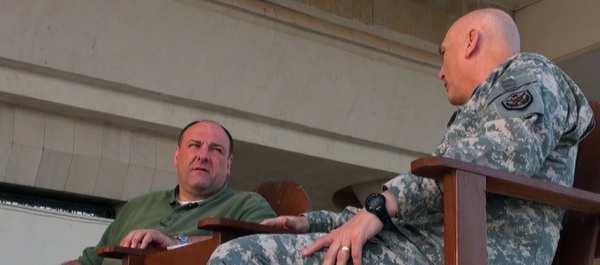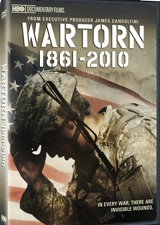Wartorn 1861 – 2010: DVD Review

General Peter Chiarelli, vice-chief of staff of the U.S. Army, described HBO’s documentary Wartorn 1861–2010 as, "The most powerful hour of TV I’ve ever seen."
That may be an understatement.
Wartorn examines the effects of post-traumatic stress disorder, commonly called PTSD, on combat veterans and their families, from the American Civil War to the current wars in Iraq and Afghanistan. The stories aren’t pretty—and that’s exactly why you should watch this documentary, especially if you, a family member or a friend is a combat veteran. If you missed Wartorn when it aired on HBO in October 2010, it is being released on DVD this month.
{default}Post-traumatic stress disorder has had other names in the past: melancholia, shell shock, combat fatigue. A rose by any other name has just as many thorns. As this program demonstrates, the emotional and mental toll of combat has always been high. No matter the century, the symptoms are similar: nightmares, difficulty sleeping and eating, anger, depression, self-loathing guilt, suicidal tendencies.
The tragic story of Angelo Crapsey of the 1st Pennsylvania Rifles during the Civil War is told through his letters and the written testimony of family and friends. In the first letter, he reports that a sergeant has committed suicide and several men have deserted. He expects that he will bear up like a man, however.
As the months and battles roll by, his letters show a decline in his confidence. After returning home, he is withdrawn and sullen. Friends begin to avoid him. Finally, he takes his own life.
Colonel Herbert B. Hayden, West Point Class of 1907, couldn’t shake images of what he saw in World War I and wrote that he had "an insane desire to kill myself, as four other friends had done."
A post–World War I headline shown in Wartorn reads, "76,688 Veterans Have Nervous Ills."
 A group of World War II vets, men who fought in the Bulge and on Iwo Jima and were diagnosed with PTSD 50 years after the war ended, relate their stories on-camera. One says, "I came home a raving lunatic," and acknowledges he has three boys he hasn’t seen in 25 years; they won’t talk to him.
A group of World War II vets, men who fought in the Bulge and on Iwo Jima and were diagnosed with PTSD 50 years after the war ended, relate their stories on-camera. One says, "I came home a raving lunatic," and acknowledges he has three boys he hasn’t seen in 25 years; they won’t talk to him.
Another remarks, "I thought I was the only one in the world who felt the way I did." The Greatest Generation was also the silent generation when it came to revealing their feelings.
A Vietnam veteran, a former US Marine combat illustrator comments that the Marines were trained to be "mad dogs" in combat—he doesn’t use the term pejoratively—and adds, "I was a good mad dog … and now I don’t know how to get rid of it."
While these historic accounts taken from Wartorn demonstrate that PTSD, by whatever name, isn’t a new problem, most of the documentary takes place in the present day. James Gandolfini—best known to audiences as the mob boss Tony Soprano whose depression and anxiety led him to seek psychiatric help in HBO’s The Sopranos—interviews active-duty veterans, from enlisted grunts to General Raymond Odierno, who was commander of US forces in Iraq at the time of the filming. Gandolfini and Sheila Nevins were co-executive producers on Wartorn.
General Odierno sums up the Catch-22 regarding PTSD: "We train … to be mentally and physically tough, so it’s hard for those individuals to admit they have problems … I think people don’t understand what we go through here … You go from calm to absolute chaos like that (snaps fingers)."
His own son was seriously wounded in Iraq.
More intense, even, than the stories told by older vets and active-duty personnel are those from family members whose sons and brothers committed suicide or have become remote and/or angry.
"It’s not just the soldier in combat who comes home with PTSD," says a man from a military family, filmed in a home where paintings of military history hang on virtually every wall. "It’s the entire family." His brother, a veteran of Afghanistan, killed himself after unsuccessfully seeking psychological treatment from the Army.
And that is why this documentary is important. It is often difficult to watch and to listen to the stories of broken lives and broken families, but families, friends and military comrades of those who have been in combat—and those combat veterans themselves—need to be aware of the signs of PTSD and the sources for help.
This is especially true for National Guard and Reserve troops. The military culture is more aware of the potential for problems among its veterans now, and its "shut up and man up" culture is gradually changing. There are now some 3,000 trained therapists in Veteran Administration Hospitals, and over 500 in the Department of Defense. Guard and Reserve troops, however, "disappear" back into their communities after returning from deployment and may not be aware of the help that is available if they are suffering from anger or depression.
 The Wartorn DVD includes a special feature, a panel discussion that was held at the Pentagon immediately after the initial airing of the documentary on October 28, 2010. It includes therapists, officers, and decorated veterans.
The Wartorn DVD includes a special feature, a panel discussion that was held at the Pentagon immediately after the initial airing of the documentary on October 28, 2010. It includes therapists, officers, and decorated veterans.
One panel member, Paul W. Bucha who received the Medal of Honor for his actions in Vietnam puts it bluntly: One hundred percent of the people who have been in combat are affected mentally and emotionally by their experiences, to one degree or another.
"We have to reach the point where everyone gets psychological conditioning," he says.
Active-duty service members, veterans, and their families seeking information or support in dealing with PTSD can call 1-800-342-9647 or go to www.militaryonesource.com.
The National Suicide Prevention Hotline can be reached at 1-800-273-TALK (8255) or www.suicidepreventionlifeline.org/veterans.
Wartorn 1861–2010, a presentation of HBO films in association with Attaboy Films, will be available on DVD May 17, 2011.
Click here to read Vietnam magazine’s interview with former US Army chaplain James D. Johnson, author of Combat Trauma: A Personal Look at Long-Term Consequences.
Click here to read an interview with Jeremiah Workman, author of Shadow of the Sword: A Marine’s Journey. Workman earned the Navy Cross for his actions in Fallujah but was suicidally self-destructive upon returning to the States.
About the author:
Gerald D. Swick is senior online editor for the Weider History Group. As a child, he was cautioned never to ask an elderly uncle about that uncle’s experiences in World War I because it would upset the man. In later years, he witnessed PTSD-linked behavior in friends who had been wounded in combat.


Hi.
I am a chiropractic physician in St. Louis, MO. I am in the process of developing a 4 hour post-graduate seminar for the doctors on the subject of brain injury, TBI, and PTSD both in the private sector and as it occurs with military personnel. I am in the process of gathering permission to use a few videos to be viewed and discussed in the class. I would very much like to have permission for the presentation of Wartorn 1861-2010 for teaching purposes.
I would appreciate it if you would tell me how to go about getting permission and who I need to contact.
This area of subject matter has become most interesting to me since 2005 when my husband and I were in a car/truck accident resulting in my personally having moderate TBI and PTSD.
Please email a reply. Thanks.
Your in Health,
Dr. Dolores P. Grebe-Jones
Hi.
I am a chiropractic physician in St. Louis, MO. I am in the process of developing a 4 hour post-graduate seminar for the doctors on the subject of brain injury, TBI, and PTSD both in the private sector and as it occurs with military personnel. I am in the process of gathering permission to use a few videos to be viewed and discussed in the class. I would very much like to have permission for the presentation of Wartorn 1861-2010 for teaching purposes.
I would appreciate it if you would tell me how to go about getting permission and who I need to contact.
This area of subject matter has become most interesting to me since 2005 when my husband and I were in a car/truck accident resulting in my personally having moderate TBI and PTSD.
Please email a reply. Thanks.
Yours in Health,
Dr. Dolores P. Grebe-Jones